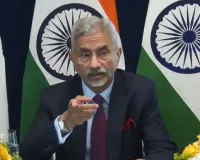Air India crash: International media highlights fuel switch anomaly revealed by AAIB report

The crash of Air India Flight AI171 in Ahmedabad, which claimed over 260 lives, has drawn intense international media scrutiny, with leading publications such as The Guardian, The Washington Post, and The New York Times focusing on the mysterious dual-engine shutdown just seconds after takeoff. Most reports rely on the recently released preliminary findings from India’s Aircraft Accident Investigation Bureau (AAIB), while stressing that the full picture will only emerge with the final report.
Fuel switches, cockpit confusion dominate headlines
British daily The Guardian headlined its coverage on the apparent accidental activation of engine fuel cut-off switches, citing the AAIB’s preliminary report. The paper highlighted the 98 seconds between takeoff and the aircraft’s crash into a medical college hostel in Ahmedabad, noting cockpit confusion and the sudden loss of engine thrust as key concerns.
The publication described the incident as the first fatal crash involving a Boeing 787 Dreamliner, adding that the circumstances have raised alarm among global aviation experts and regulators. The Guardian also drew attention to the pilot’s brief attempt at recovery before the aircraft’s descent became irreversible.
Washington Post probes procedural lapses, expert views
The Washington Post offered a more analytical take, focusing on whether the fuel switches were activated unintentionally and if standard safety procedures were followed in the cockpit. The report cited aviation experts who said such switch activation is extremely rare and would require further scrutiny of human factors, system design, and crew response.
The Post’s coverage raised broader questions about India’s aviation oversight and transparency in the investigation process. It also noted that the lone survivor, a British national, had not yet been publicly interviewed, but could prove critical in the inquiry ahead.
New York Times urges caution, emphasises pending questions
The New York Times took a balanced approach in its reporting, summarising the AAIB’s key findings while underlining that no definitive cause has been established. The Times emphasised that both flight data and cockpit voice recordings revealed a sudden and unexplained shutdown of fuel to both engines, but refrained from speculating beyond the preliminary evidence.
Its coverage highlighted the importance of allowing the full investigation to play out before drawing conclusions, especially given the global attention on Boeing aircraft safety and the Indian civil aviation sector.
Global focus on India’s aviation safety and investigation standards
The crash, involving a Dreamliner en route from Ahmedabad to London, has amplified global focus on India’s aviation infrastructure and safety protocols. The coordinated and transparent release of the AAIB’s preliminary report has been noted positively in most international media, though many also flagged the need for faster implementation of safety audit reforms and training procedures for complex aircraft systems.
As the final report is awaited, the crash continues to serve as a grim reminder of the fragile intersection between modern aviation technology, human factors, and emergency preparedness. More global coverage is expected in the coming weeks as additional findings emerge.
About The Author
Welcome to Aryan Age, an English newspaper that has been serving readers since 2011 from Delhi. With a loyal circulation of over 19,000, we are dedicated to providing our readers with the latest news and information, as well as insightful analysis and commentary that help them navigate the complex and rapidly changing world.










Comment List